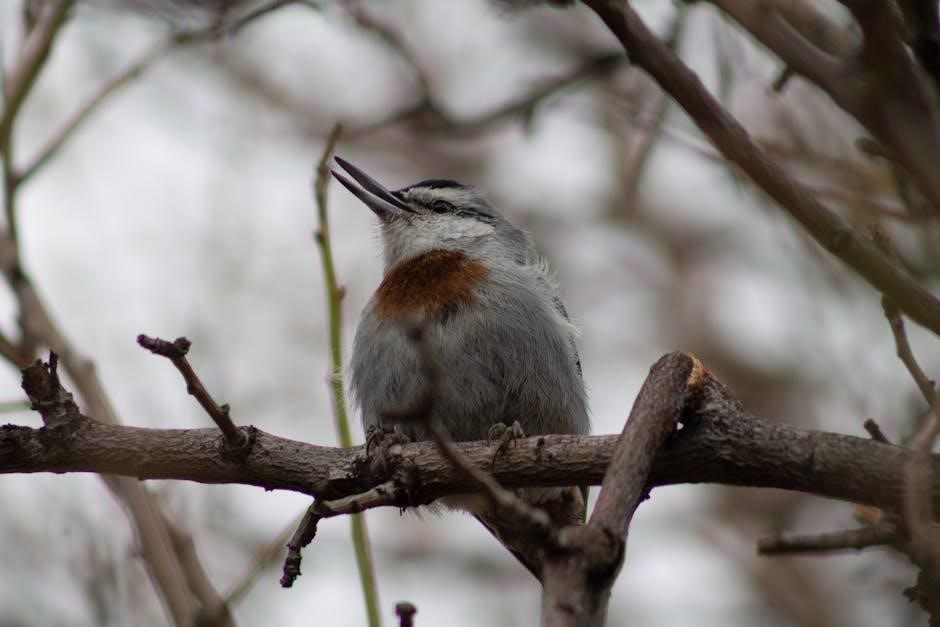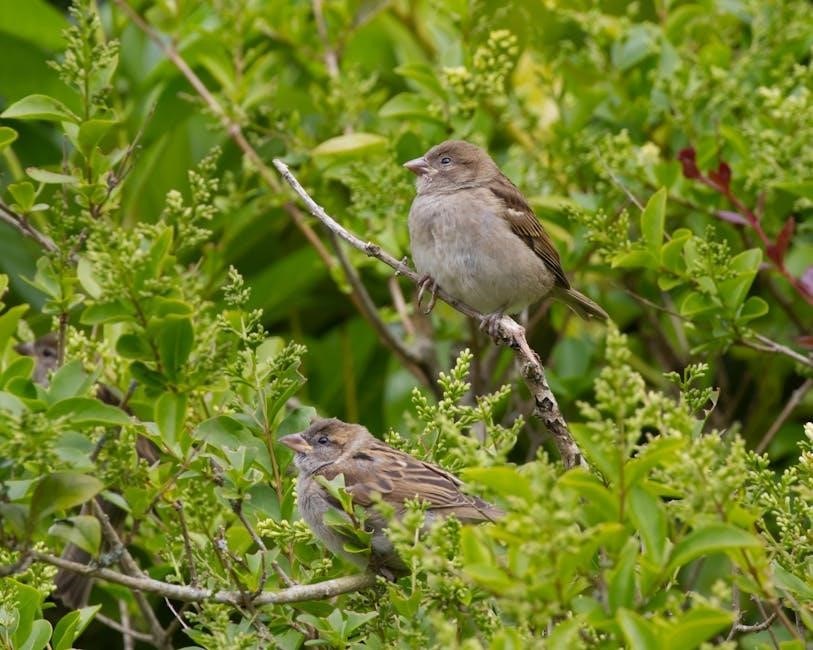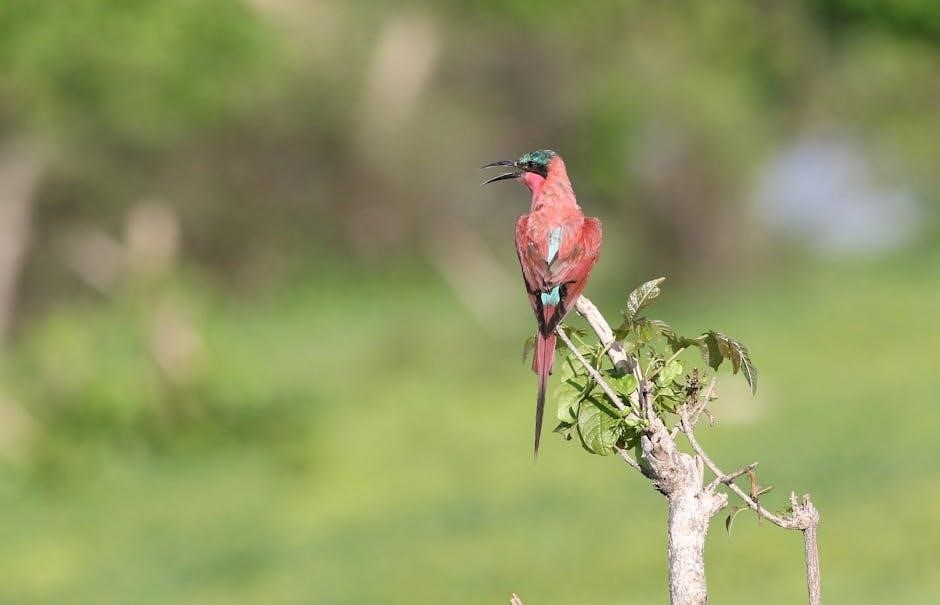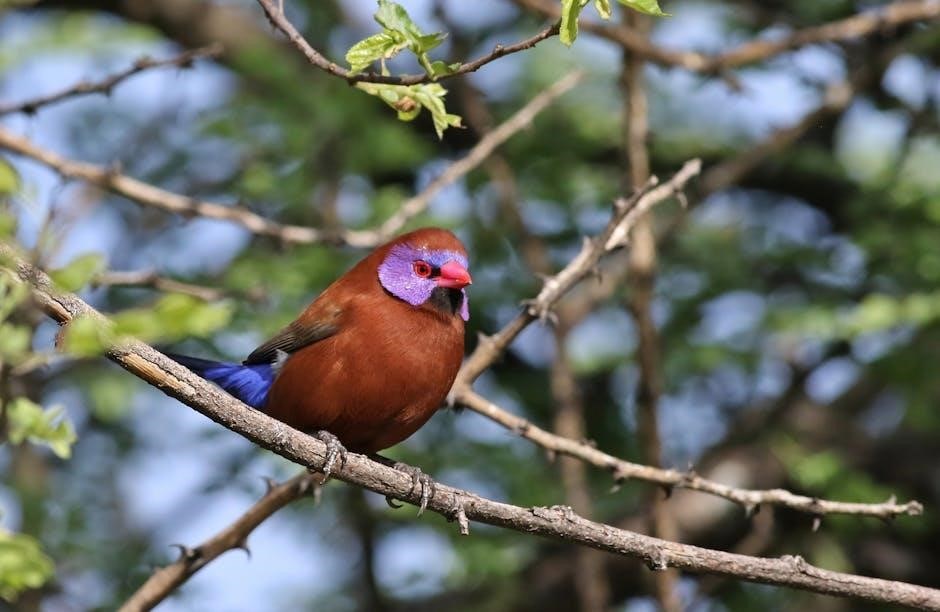Birds, vital to ecosystems, face growing threats from habitat loss, pollution, and climate change, highlighting the need for awareness and conservation efforts to protect these crucial species․
1․1 Understanding the Challenges Faced by Birds
Birds face numerous challenges that threaten their survival․ Habitat destruction due to deforestation and urbanization reduces their living spaces, making it harder for them to find food and shelter․ Pollution from industrial waste and pesticides contaminates their environments, leading to health issues․ Climate change disrupts ecosystems, altering food supplies and breeding patterns, making it difficult for birds to adapt․ These challenges, often exacerbated by human activities, have a cumulative impact on bird populations․ Understanding these issues is essential for developing effective conservation strategies to protect bird species and ensure their survival in a rapidly changing world․

Identifying Signs of Distress in Birds
Recognizing signs of distress in birds is crucial for early intervention․ Look for unusual behaviors, labored breathing, or physical changes, as these indicate potential health issues․
2․1 Physical Indicators of Illness or Injury
Birds exhibiting illness or injury often show distinct physical signs․ Plumage may appear ruffled, dirty, or molted unevenly․ Labored breathing, discharge around the eyes or beak, and swelling in the feet or legs can indicate health issues․ Feather pecking, sores, or unusual growths on the skin are red flags․ Birds with injuries may have visible wounds, fractures, or blood․ Beak and feather conditions, such as overgrowth or discoloration, can signal underlying problems․ Drooping wings, limping, or an inability to perch properly are also signs of distress․ Observing these physical indicators helps in identifying when a bird needs urgent care and attention․

2․2 Behavioral Changes in Troubled Birds
Birds often exhibit behavioral changes when they are unwell or distressed․ A reduction in activity, such as lethargy or reluctance to fly, can signal illness․ Vocalizations may become abnormal, with unusually loud, frequent, or strained calls․ Troubled birds may stop foraging or show a lack of interest in food, leading to weight loss․ Social birds may withdraw from their flock, while solitary birds may become unusually tame or approach humans․ Pacing, feather plucking, or excessive preening can indicate stress or discomfort․ In severe cases, birds may tremble, lose balance, or display erratic flight patterns․ Recognizing these behavioral shifts is crucial for early intervention and care․

Common Health Issues in Birds
Birds often suffer from parasites, infections, and respiratory problems, while nutritional deficiencies and metabolic disorders also pose significant threats to their health and well-being․
3․1 Parasites and Infections in Birds
Birds are frequently afflicted by external parasites such as mites, lice, and ticks, which can cause skin irritation, feather damage, and anemia․ Internal parasites, including tapeworms and roundworms, often lead to digestive issues, weight loss, and reduced vitality․ These parasites can be transmitted through contaminated food, water, or contact with infected birds․ Infections, particularly bacterial and fungal ones, are another prevalent health concern, often arising from poor living conditions or weakened immune systems․ Symptoms may include labored breathing, lethargy, or unusual droppings․ Early detection and treatment by a veterinarian are crucial to prevent severe complications․ Proper hygiene, a balanced diet, and regular check-ups can significantly reduce the risk of parasitic infections, ensuring the overall well-being of birds․
3․2 Nutritional Deficiencies and Their Impact
Nutritional deficiencies are a common issue in birds, often stemming from inadequate or imbalanced diets․ A lack of essential vitamins, minerals, or proteins can lead to various health problems․ For instance, vitamin A deficiency can cause respiratory issues and impaired vision, while calcium deficiency may result in brittle bones or egg-laying difficulties․ Protein deficiency can weaken a bird’s immune system, making it more susceptible to infections․ Feather plucking, poor growth, and lethargy are common signs of malnutrition․ Providing a balanced diet tailored to a bird’s species-specific needs is crucial for preventing these issues․ Supplements may be necessary in some cases, but they should be used judiciously under veterinary guidance․ Regular check-ups and a focus on high-quality food sources can help mitigate the risks of nutritional deficiencies, ensuring birds maintain optimal health and vitality․

Environmental Factors Affecting Bird Health

Environmental factors such as pollution, climate change, and habitat destruction significantly impact bird health, leading to reduced populations and increased vulnerability to diseases and predators worldwide․
4․1 Habitat Loss and Its Effects on Bird Populations
Habitat loss is a critical threat to bird populations, as it reduces nesting, breeding, and foraging areas․ Deforestation, urbanization, and agricultural expansion have led to the destruction of natural ecosystems, forcing birds into smaller, fragmented habitats․ This fragmentation disrupts migration patterns, isolates populations, and increases competition for resources․ Many bird species, particularly those dependent on specific habitats like rainforests or wetlands, are disproportionately affected․ The loss of migratory stopover sites further endangers long-distance travelers, exacerbating population declines․ Habitat loss also makes birds more vulnerable to predators and climate change, creating a ripple effect across entire ecosystems․ Without urgent conservation efforts, including habitat restoration and protection, many bird species face extinction․ Addressing habitat loss requires global cooperation to preserve and restore critical ecosystems for avian survival․
4․2 Climate Change and Its Role in Bird Distress
Climate change poses significant threats to bird populations worldwide․ Rising temperatures alter habitats, disrupt breeding cycles, and reduce food availability, leading to malnutrition and starvation․ Melting ice caps and shifting weather patterns impact migratory routes, causing disorientation and exhaustion․ Extreme weather events, such as hurricanes and droughts, destroy nesting sites and displace birds․ Additionally, climate change facilitates the spread of diseases and parasites, further endangering vulnerable species․ Coastal birds face heightened risks from sea-level rise, while Arctic species lose critical ice-dependent habitats․ These changes disrupt ecosystems, leading to population declines and even extinctions․ Addressing climate change requires global efforts to reduce emissions and protect habitats, ensuring the survival of avian species in a rapidly changing world․
Rehabilitation and Care for Troubled Birds
Rehabilitation involves providing medical care, proper nutrition, and a safe environment to injured or distressed birds, ensuring their recovery and eventual release back into the wild․
5․1 Initial Steps in Caring for an Injured Bird
When encountering an injured bird, handle it gently with clean, gloved hands or a soft cloth to minimize stress and prevent further harm․ Place the bird in a secure, ventilated container lined with a towel or paper to provide stability․ Keep the environment calm, dark, and quiet to reduce stress․ Maintain a comfortable temperature, typically around 80-90°F, depending on the species․ Avoid feeding the bird immediately, as improper food can cause harm․ Seek professional help from a licensed wildlife rehabilitator or veterinarian promptly․ Keep the bird isolated from pets and children to ensure safety․ Monitor for signs of distress, such as labored breathing or lethargy, and act accordingly․ Remember, immediate care is critical for recovery, so prioritize quick, responsible action․

5․2 Creating a Safe Environment for Recovery
Creating a safe environment for an injured bird is essential for its recovery․ Provide a secure, escape-proof enclosure with adequate ventilation to prevent respiratory issues․ Line the base with soft, dry material like towels or paper to ensure comfort․ Maintain an appropriate temperature, typically between 75-85°F, depending on the species․ Use a heat source if necessary, but avoid direct sunlight or extreme heat․ Ensure low noise levels and minimize disturbances to reduce stress․ Offer fresh water in a shallow dish for drinking and light misting to maintain humidity․ Provide a balanced diet suitable for the bird’s species, avoiding harmful foods․ Monitor the bird’s condition closely and seek professional advice if signs of distress or illness persist․ A calm, safe environment fosters healing and prepares the bird for eventual release․

Conservation Efforts for Bird Populations
Conservation efforts are vital to protect bird populations, focusing on habitat preservation, pollution reduction, and addressing climate change impacts to ensure sustainable ecosystems for future generations of birds․
6․1 Protecting Natural Habitats and Ecosystems
Protecting natural habitats is crucial for bird survival, as these environments provide essential resources like food, shelter, and breeding grounds․ Habitat loss, often due to deforestation, urbanization, and agricultural expansion, disrupts bird populations and threatens their existence․ Conservation efforts must focus on preserving and restoring ecosystems, such as forests, wetlands, and grasslands, which are vital for bird diversity․ Protected areas, like national parks and wildlife reserves, play a key role in safeguarding these habitats․ Additionally, initiatives to promote sustainable land use and reduce pollution can help maintain healthy ecosystems․ By preserving natural habitats, we ensure that birds have the spaces they need to thrive, supporting their role in maintaining balanced and resilient ecosystems․ This approach is essential for the long-term survival of bird species and the overall health of our planet․
6․2 Community Involvement in Bird Conservation
Community involvement is a cornerstone of effective bird conservation, fostering a sense of responsibility and engagement among individuals․ Local initiatives, such as bird-watching groups, clean-up drives, and nesting site protections, empower people to contribute directly to bird welfare․ Citizen science projects allow communities to collect valuable data on bird populations, aiding researchers in understanding trends and threats․ Educational programs and workshops further raise awareness about the importance of conservation and how to implement it․ Encouraging eco-friendly practices, such as planting native vegetation and reducing pesticide use, also fosters habitats for birds․ Collaboration between communities, NGOs, and governments amplifies these efforts, creating a unified front for bird protection․ By involving everyone, conservation becomes a shared goal, ensuring a brighter future for troubled bird species and the ecosystems they inhabit․
The Role of Humans in Helping Troubled Birds

Humans play a vital role in safeguarding troubled birds through conservation, care, and education, ensuring their survival and well-being in challenging environments․ Collective efforts and awareness are key to protecting these species․
7․1 Responsible Practices for Birdwatchers and Enthusiasts
Responsible birdwatching involves maintaining a safe distance to avoid stressing birds, using binoculars for observation, and keeping the environment clean by disposing of waste properly․ Bird feeders should offer appropriate food sources like seeds or nectar, avoiding harmful options such as bread․ Feeding should be done in moderation to prevent dependency on humans․ Birdwatchers must respect protected areas, avoid disturbing nests, and refrain from touching or handling birds unless necessary․ Supporting conservation efforts, such as participating in bird counts or donating to wildlife organizations, is also crucial․ Additionally, minimizing the use of pesticides and creating bird-friendly habitats in gardens can significantly benefit bird populations․ By adhering to these practices, enthusiasts can enjoy birdwatching while contributing positively to their well-being and conservation․
7․2 Legal and Ethical Considerations in Bird Care
Engaging in bird care requires adherence to legal and ethical standards to ensure the well-being of birds and compliance with local and national regulations․ Many bird species are protected under wildlife laws, such as the Endangered Species Act, making it illegal to handle or keep them without proper authorization․ Ethically, caregivers must prioritize the bird’s welfare, avoiding actions that could cause further stress or harm․ This includes minimizing human contact to prevent imprinting and ensuring rehabilitation efforts aim for eventual release into the wild․ Additionally, caregivers should consult licensed wildlife professionals for guidance․ Legal permits are often necessary for rehabilitating injured or orphaned birds, and violating these regulations can result in fines or penalties․ Ethical bird care also involves transparency about one’s qualifications and resources․ By adhering to these principles, individuals can contribute responsibly to bird conservation and welfare․
Protecting troubled birds requires collective action, conservation efforts, and responsible practices to safeguard their populations and ecosystems, ensuring a harmonious coexistence with nature for generations to come․

8․1 The Importance of Collective Action for Bird Welfare
Collective action is vital for safeguarding bird populations, as individual efforts, community initiatives, and global collaborations combine to address habitat loss, climate change, and pollution․ By fostering awareness and education, societies can inspire responsible practices, such as sustainable living and eco-friendly policies․ Governments, organizations, and citizens must unite to protect critical habitats and advocate for bird-friendly legislation․ Every contribution, no matter how small, plays a role in preserving biodiversity․ The collective commitment to conservation ensures a healthier planet for birds and future generations, highlighting the power of unity in addressing environmental challenges and promoting wildlife welfare․


